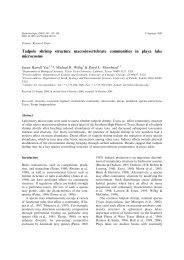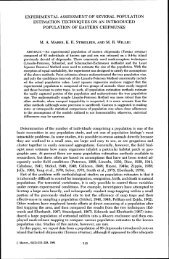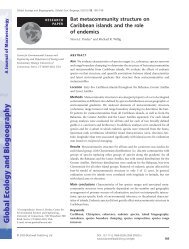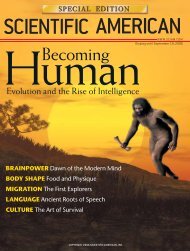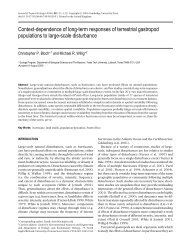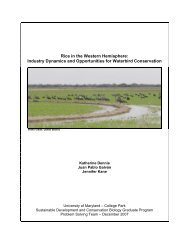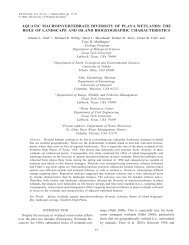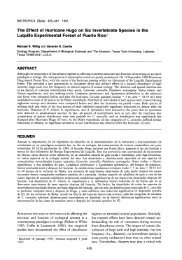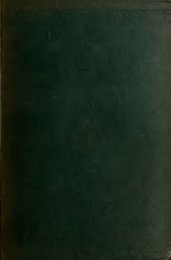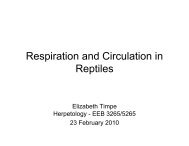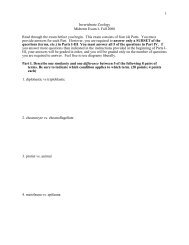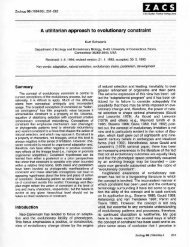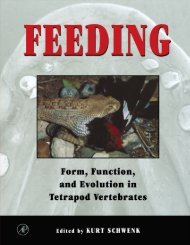Comparative biology and the importance of cladistic classification: a ...
Comparative biology and the importance of cladistic classification: a ...
Comparative biology and the importance of cladistic classification: a ...
Create successful ePaper yourself
Turn your PDF publications into a flip-book with our unique Google optimized e-Paper software.
72 K. SCHWENK<br />
Classifications, like language, not only reflect our thought, but direct <strong>and</strong><br />
constrain it (Harvey <strong>and</strong> Pagel, 1991; Woese, K<strong>and</strong>ler & Wheelis, 1991). The<br />
reason for this is simply that many comparative biologists reb on classijications <strong>and</strong> not<br />
phylogenies to shape <strong>the</strong>ir evolutionary <strong>and</strong> functional generalizations. Can a<br />
non-<strong>cladistic</strong> <strong>classification</strong>, in fact, misdirect biological generalization? In this<br />
paper I document one such case taken from <strong>the</strong> literature on <strong>the</strong> sensory <strong>biology</strong><br />
<strong>of</strong> squamate reptiles (lizards, snakes <strong>and</strong> <strong>the</strong>ir allies). I show that a traditional,<br />
evolutionary-taxonomic (paraphyletic) <strong>classification</strong> <strong>of</strong> squamate reptiles has<br />
resulted in false generalizations regarding <strong>the</strong> sensory <strong>biology</strong> <strong>of</strong> <strong>the</strong> group; in<br />
particular it has contributed to <strong>the</strong> mischaracterization <strong>of</strong> one speciose lineage,<br />
<strong>the</strong> Gekkota, despite <strong>the</strong> existence <strong>of</strong> contradictory evidence.<br />
This case study serves two purposes: first, it provides systematists with a<br />
concrete example illustrating <strong>the</strong> pitfalls <strong>of</strong> non-<strong>cladistic</strong> <strong>classification</strong>, pitfalls<br />
feared <strong>and</strong> alluded to by proponents <strong>of</strong> cladism (e.g. Harvey & Pagel, 1991; 52),<br />
but rarely, if ever, documented. Second, it provides a cautionary tale to all<br />
comparative biologists, pointing to <strong>the</strong> need to use phylogenies <strong>and</strong> not<br />
<strong>classification</strong>s in evolutionary analyses, <strong>and</strong> to reconsider resistance to <strong>cladistic</strong><br />
revisions <strong>of</strong> traditional taxonomies.<br />
SQUAMATE CLASSIFICATION AND PHYLOGENY: BACKGROUND<br />
In 1923 Camp published his classic monograph on <strong>the</strong> relationships <strong>of</strong> <strong>the</strong><br />
lizards. This study has remained <strong>the</strong> basis for our underst<strong>and</strong>ing <strong>of</strong> squamate<br />
relationships until very recently. Camp was a product <strong>of</strong> his time, so it is not<br />
surprising that his <strong>classification</strong> is in conflict with <strong>the</strong> <strong>cladistic</strong> relationships<br />
expressed in his own published phylogeny (Fig. 2A). He divided squamates into<br />
two ‘Divisions,’ <strong>the</strong> Ascalabota <strong>and</strong> <strong>the</strong> Autarchoglossa. His Ascalabota<br />
contained <strong>the</strong> clades Iguania <strong>and</strong> Gekkota (<strong>the</strong> latter containing, at <strong>the</strong> time,<br />
only <strong>the</strong> single family Gekkonidae). In so doing, Camp (1923) was fully aware<br />
that gekkotans were more closely related to Autarchoglossans than to Iguanians<br />
<strong>and</strong> that Ascalabota represented, in modern terminology, a paraphyletic group.<br />
He chose to emphasize in his <strong>classification</strong> <strong>the</strong> retention by both iguanians <strong>and</strong><br />
gekkotans <strong>of</strong> certain primitive morphological states.<br />
Using a larger data set <strong>and</strong> <strong>cladistic</strong> methodology, Estes, de Queiroz &<br />
Gauthier, ( 1988) re-examined squamate relationships. Remarkably, <strong>the</strong>ir<br />
phylogeny does not differ substantively from that <strong>of</strong> Camp (1923) (Fig. 2). In<br />
<strong>the</strong>ir <strong>cladistic</strong> <strong>classification</strong>, Estes et al. (1988) abolished Ascalabota as a formal<br />
taxon, recognizing <strong>the</strong> sister relationship between Gekkota <strong>and</strong> Camp’s<br />
Autarchoglossa, <strong>and</strong> referred to this inclusive clade as ‘Scleroglossa’ (Fig. 2b).<br />
Their <strong>classification</strong> reflects <strong>the</strong> basal dichotomy between <strong>the</strong> clade Iguania <strong>and</strong><br />
<strong>the</strong> remaining squamates, <strong>the</strong> Scleroglossa.<br />
Kluge (1989) reanalysed Estes et al.’s (1988) data <strong>and</strong> found that <strong>the</strong>re is more<br />
ambiguity in relationships among some scleroglossan taxa than originally<br />
suggested, but he confirmed <strong>the</strong> Iguania-Scleroglossa dichotomy. This<br />
dichotomy was also independently corroborated by Schwenk (1988). There is<br />
some evidence that two <strong>of</strong> <strong>the</strong> three nominal ‘families’ <strong>of</strong> Iguania are <strong>the</strong>mselves<br />
paraphyletic (Frost & E<strong>the</strong>ridge, 1989), but <strong>the</strong> evidence is equivocal <strong>and</strong> is not<br />
relevant to <strong>the</strong> ensuing discussion. For clarity <strong>the</strong>se taxa (Iguanidae <strong>and</strong><br />
Agamidae) are treated here as if monophyletic.



